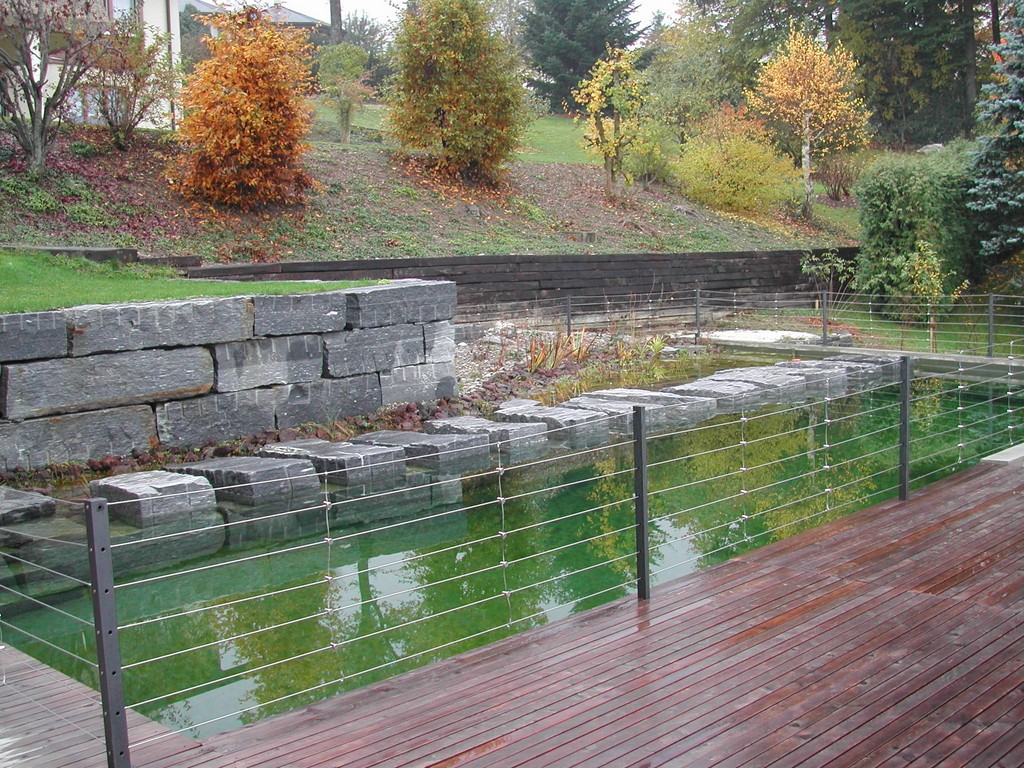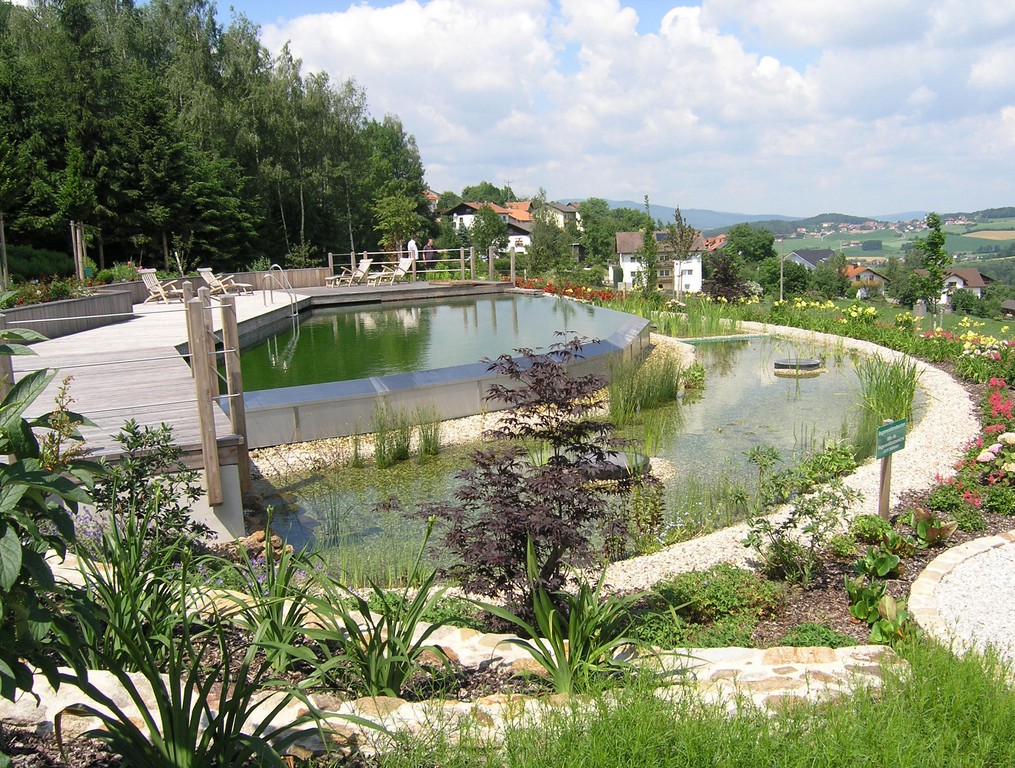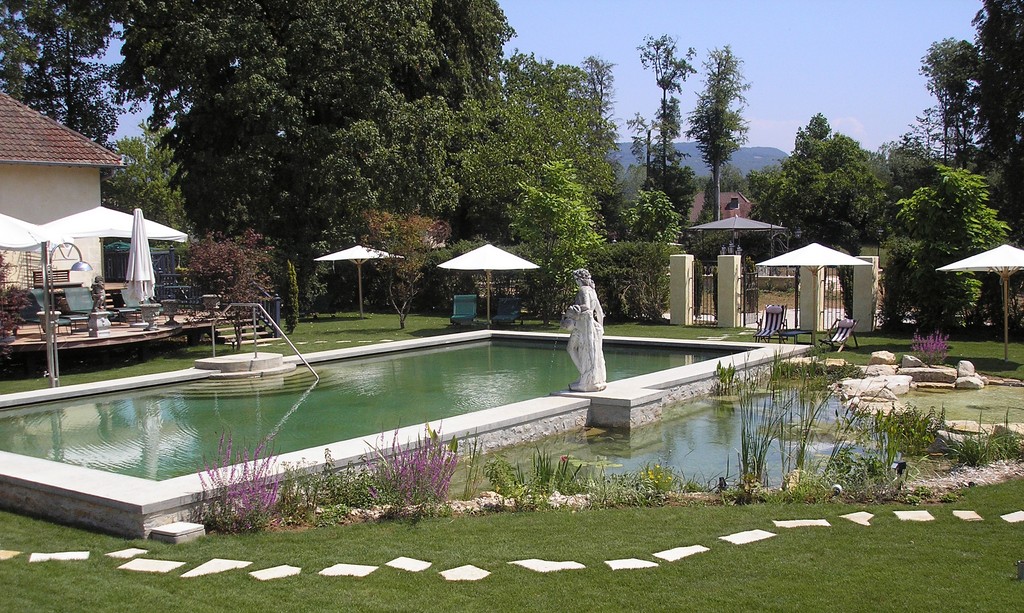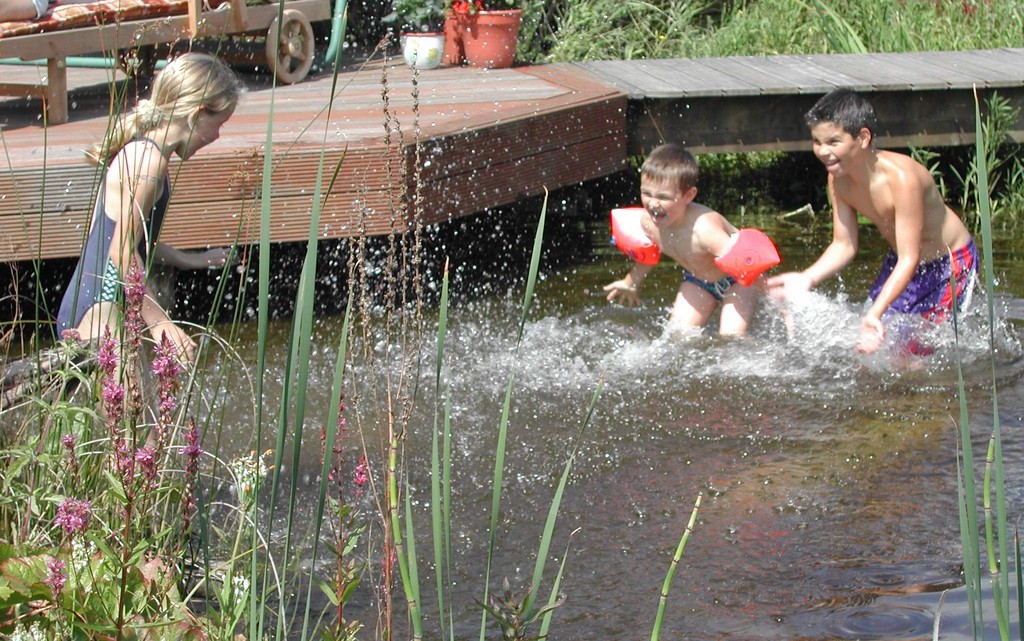Going Natural
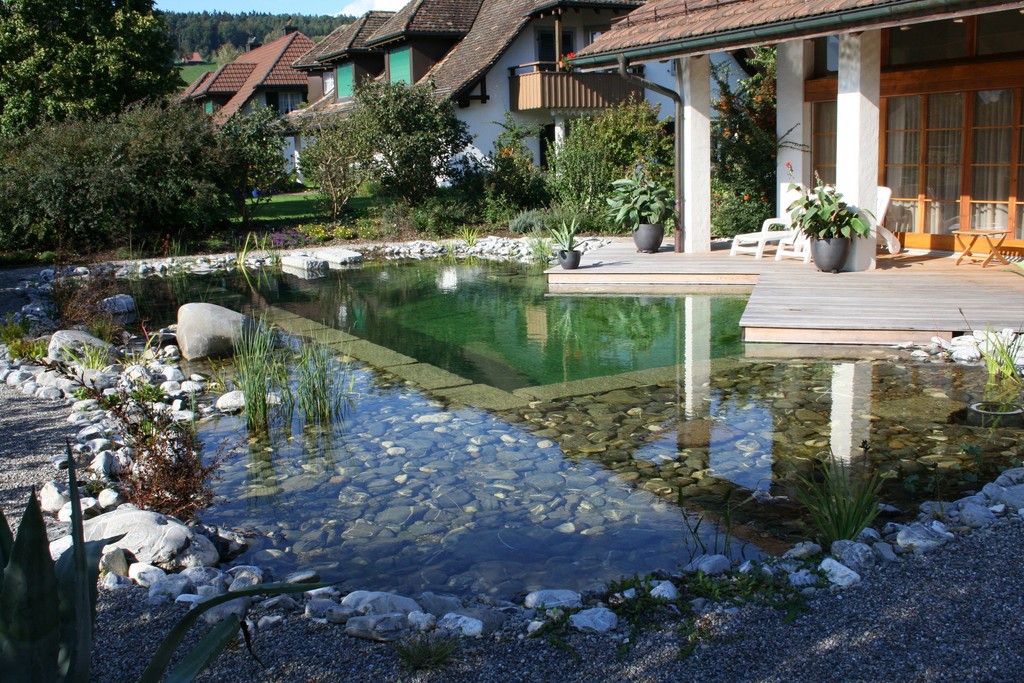
Although the concept is relatively unfamiliar in the United States and largely untested here, pools supported by an entirely natural approach to filtration and water management have been under development in Europe for decades and have caught on there in a big way in recent years. In this special feature, German watershaper and natural-pool expert Rainer Grafinger discusses the ‘technology’ behind this potent European trend.
For most people in the United States, swimming is far from a natural experience: Bathers move back and forth in man-made, chemically treated backyard or public swimming pools and seldom (if ever) find themselves in truly natural bodies of water such as lakes, rivers or oceans.
What most of these people don’t know is that it’s possible to swim in backyard pools filled with untreated water. Indeed, we’ve been building entirely natural pools for quite some time in Europe that operate without either purification equipment or chemical sanitizers. These “swimming ponds,” as some also call them, rely on natural processes to purify and balance water – the same sorts of processes that make mountain lakes and streams so refreshing.
This movement toward natural water treatment originated in Austria as long as a century ago, and by now the approach is established and broadly accepted in Europe. Our firm, BioNova of Bergkirchen, Germany, has become a passionate proponent of this form of watershaping and now provides professionals throughout Europe with designs and components for natural pools.
We are now seeing a small number of these systems being installed in North America and believe that this trend will gain worldwide momentum in coming years as swimmers become aware of and begin to ask questions about this option. To give you some worthy answers, let’s take a look at what makes these pools tick.
A FRESH APPROACH
In our designs, natural swimming pools actually consist of two sections: a swimming area for relaxation and recreation and a watergarden in which water regeneration and purification take place.
The swimming area can be a normal-looking pool with typical shapes, coping and finishes – or it can look like a pond or some hybrid combination of the two forms. The big difference is that this swimming area, whatever its configuration, is physically linked to a watergarden that supplies it with purified water.
For its part, the watergarden is basically a pond with an ecosystem specializing in water purification. This regenerative section features water-loving plants that absorb nutrients released by microorganisms involved in the decomposition of organic matter. Just as with an artificial backyard pond that supports fish and other wildlife, the watergarden is purified both biologically and mechanically as water flows through reeds and roots and is ultimately drawn down through a filtering bed of sand and gravel.
| Many of these natural swimming pools are set up in such a way that both the swimming and the pond-like regeneration zones are contained within the same vessel. In some cases, the barriers between the two areas are subtle; in others, however, they are clearly defined or even celebrated. |
A huge range of design looks is available with these pools, but what’s common to all is that costly disinfection technologies and chemical treatments are not needed. This is true for designs in which the swimming areas closely resemble natural pondscapes and feature such details as beach entries that transport clients to stream- and lakeside resorts. It’s also true for refined, architecturally inspired pools made with graceful contours, beautiful materials and fine finishes.
Experience also shows us that not only do these watershapes work in all sorts of settings and all kinds of styles, but that they also fit into a wide range of budgets. And there’s also a grand opportunity in retrofitting existing pools to accommodate this new approach.
Yet even though these pools represent a dramatic departure from tradition, they don’t involve significant operational changes for watershapers who are already familiar with pool and pond construction. The challenge as always comes in creating conditions that support and sustain stable ecological balance in closed systems.
In every case, nature serves as our guide. Natural lakes have zones with water at various depths and are home to indigenous plants. Water treatment primarily takes place in the shallow-water zones at the fringes of these ponds, where cattails, sedges and canes predominate. These plants absorb nutrients to fuel their survival and continued growth.
This fringe is also where small animals find food and protection, but our interest here is in the filtering function that happens in this zone as water flows through the plants on its way to the sand/gravel bed below.
SEPARATE VESSELS
In one of the several configurations we use in designing and installing these watershapes, we contain both the swimming area and the regenerating plant zone within the same vessel, masking the construction measures we take to separate them physically so that one, unified structure seems to allow for the coexistence of people, animals and plants.
Distinct separation methods are important, because we want to keep any strong currents of the swimming area or the circulation system from disrupting calm flows within the watergarden. We fashion these barriers with concrete, acrylic panels, natural stone or timber planks that rise from the bottom of the vessel to within inches or even fractions of inches of the water’s surface so that the unified appearance of the vessel remains visually intact.
In other designs, we separate the swimming and regenerative functions into two vessels, either adjacent to one another or at some distance apart. In the former case, we’ll often set one vessel slightly above the other and have one flow gently down – it doesn’t matter whether the swimming area is above the regenerative area or vice versa. In warmer climates, however, we set up two bodies of water and put some distance between them because we need greater control over how they interact.
| A distinctive visual drama results when the two zones are established on different levels and one spills into the other, but the same can be true when the two zones seem to function completely apart from one another. This lends tremendous design flexibility to this approach to watershaping and allows us to consider the full range of looks, from the purely naturalistic to the architecturally formal. |
Wherever they’re installed, these natural swimming pools are closed systems, so sealing is especially important. This is why, in addition to installing concrete shells, we always line our regenerative ponds with liners: Their flexibility helps us shape natural-seeming shorelines and embankments in ways familiar to pond installers, but we also line our swimming areas as well just to make certain there are no outside intrusions upon the system.
The technical requirements for these liners are described in various standards and regulations applied throughout Europe. They must have expansion capability and resist tearing, aging, ultraviolet radiation, frost and root penetration, which means we can choose among PVC (polyvinyl chloride), PE (polyethylene), EPDM (synthetic rubber) and FPO-A (flexible polyolefin) liners in thicknesses of 1.5 to 2 mils.
Within our regeneration zones, we also spread a fibrous web over the liner to serve as mechanical protection. All lining in the regeneration zone is then covered with gravel and sand to establish the underlying filtration system. We also use gravel in the shallow areas of the swimming zone, but deeper areas are left uncovered so water can be drawn off to the purification system with ease.
As a rule, the swimming and regeneration zones in typical projects are set up in a one-to-one ratio with respect to surface area. But as is often the case in system design, the rules change as the overall size of a project grows: The more water there is, the more stable the overall system becomes, so in certain situations the regeneration zone can become smaller relative to the swimming zone.
KEY DECISIONS
Ultimately, many of the decisions about which specific way to go – one vessel with an interior separation, two vessels with one flowing directly into the other, or two separate and distinct vessels – are driven by the property owners, the setting and a variety of aesthetic goals.
Do the owners want a unified, nature-oriented swimming pond that blends in with the garden landscape? Or are they after a more conventional pool for which the watergarden is no more than a purification system? Should the vessels be side by side? Should the regeneration zone not even be visible? These decisions are fundamental to the way the overall space will be organized and designed.
Whether or not a particular location is even suitable for such a watershape can depend on how much sun exposure and shade there is, given the plants’ need for sunlight. Some consideration must also be given to placements near existing trees, as you want to minimize nutrient input. Finally, thought should be given to isolating these systems from the wind, again to minimize the introduction of debris.
| Experience has shown that numerous homeowners and commercial-facility managers like the thought of chemical-free, naturally purified water – and that children (and adult bathers as well) take to the water and enjoy it in just the same way as they do conventional, treated pools. There are technical distinctions that might take some explaining, but the functional differences are relatively few. |
Then you need to ask: What relative zone sizes does a specific system require? Where should they go? How will access to the water be provided? Will there be enough space for a gradual beach entry? Or will there be conventional steps down into the swimming area? Is there to be a special shallow area in which small children are to play? Other than the fact that two vessels (either unified or separate) are being discussed, this is a normal set of issues for discussion in the design stage of any watershape project.
But the dual nature of the environment leads us to reach a bit beyond the conventional list of possibilities to be discussed. These are, after all, systems that include ponds as well as pools.
This, for example, is where we get into discussions about such details as having stepping stones pass through the regeneration zone – an odd case where pond installers need to think more like pool builders because, for stabilization purposes, each stepping stone will need to be placed in a mortar bed that reaches down to a stable surface beneath the waterline. (These stones often come up because they allow property owners or maintenance personnel to move freely throughout the regeneration zone without disturbing the water.)
Along with such specialized features, we also cover the usual range of waterfeatures that accompany modern pools and ponds, from associated streams and waterfalls to more architecturally oriented fountains and jets – not to mention underwater lighting systems, massage stations and counter-current swimming devices. Almost anything is possible so long as details applied in the swimming area don’t disturb the vegetation in the regeneration zone.
SMART LAYOUT
Once the location and detailing have been determined, a whole range of practical issues must be settled.
In these systems, for instance, water flows through the pool and is drawn into the regenerative system from its deepest point, but as with conventional pool systems, there must also be a means of skimming debris off the surface, thus requiring the layout of gutters or skimmers. You also need to consider placement of the equalizing tank and equipment pad as well as the basic configuration of the water-circulation system.
The basic aim is to set up circulation systems that skim the water’s surface and transport the water to be purified beneath the root zone of the pond. In addition, these systems also must oxygenate the water to keep the decomposition processes moving along. These tasks are all easily handled by conventional hydraulic designs using familiar centrifugal pumps.
| Natural swimming pools are safe havens for swimmers and casual bathers, but what we like about them as watershapers is the fact that they afford us the opportunity to deliver fully naturalistic watershapes to clients in forms that help ease day-to-day stresses, please the eye and foster relaxation at the water’s edge at least as much as they encourage their owners to exercise and enjoy family-style fun in the water. |
Throughout this article, I’ve tried to make the point that, although the basic concept of natural swimming pools may be new to many watershapers in the United States, literally thousands of them have been installed in Europe using techniques and technologies that are familiar to North American watershapers – although they’re applied in slightly different ways in a few cases.
The bottom line here is that we’ve found a large population of homeowners (and even commercial-property developers) who are captivated by the prospect of swimming in chemical-free, naturally purified water – and don’t object to the fact that they can also save money up front and in the long run by eliminating the cost of chemicals and/or other water-treatment technologies.
To be sure, the water in natural swimming pools looks different from the pristine water of chemically treated pools: There’s a degree of turbidity that requires an adjustment in client expectations. But here in Europe, where rules about water use are as strict (if not more strict) than they are anywhere elsewhere in the world, the degree of public acceptance of these pools is high. Moreover, European regulators now readily accept this approach to water treatment, having found these pools (when properly installed and maintained, of course) to be completely safe for bathers.
It may represent a radical shift in approach, but with environmental concerns becoming more and more important in upscale consumers’ minds, it’s not unreasonable to see natural swimming pools as an idea whose time may have come.
Rainer Grafinger operates BioNova, a worldwide network of watershapers that focuses exclusively on the design and installation of swimming pools treated entirely using natural processes. A licensed engineer, he has been designing private natural swimming pools since 1994 and commercial natural pools since 1996. An avid proponent of the concept, Grafinger has organized numerous training courses, conferences and lectures on the subject throughout Europe, using headquarters near Munich, Germany, as his base of operations. He has served as president of the German Society for Natural Swimming Associations and as vice president of the International Association for Swimming.













